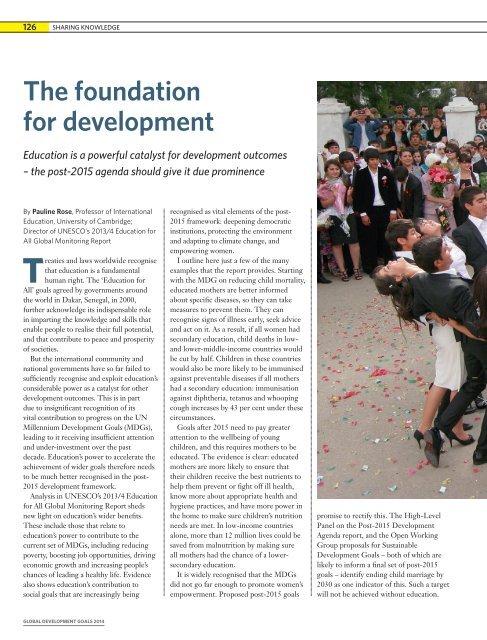FAMBB
FAMBB
FAMBB
You also want an ePaper? Increase the reach of your titles
YUMPU automatically turns print PDFs into web optimized ePapers that Google loves.
126 SHARING KNOWLEDGEThe foundationfor developmentEducation is a powerful catalyst for development outcomes– the post-2015 agenda should give it due prominenceBy Pauline Rose, Professor of InternationalEducation, University of Cambridge;Director of UNESCO’s 2013/4 Education forAll Global Monitoring ReportTreaties and laws worldwide recognisethat education is a fundamentalhuman right. The ‘Education forAll’ goals agreed by governments aroundthe world in Dakar, Senegal, in 2000,further acknowledge its indispensable rolein imparting the knowledge and skills thatenable people to realise their full potential,and that contribute to peace and prosperityof societies.But the international community andnational governments have so far failed tosufficiently recognise and exploit education’sconsiderable power as a catalyst for otherdevelopment outcomes. This is in partdue to insignificant recognition of itsvital contribution to progress on the UNMillennium Development Goals (MDGs),leading to it receiving insufficient attentionand under-investment over the pastdecade. Education’s power to accelerate theachievement of wider goals therefore needsto be much better recognised in the post-2015 development framework.Analysis in UNESCO’s 2013/4 Educationfor All Global Monitoring Report shedsnew light on education’s wider benefits.These include those that relate toeducation’s power to contribute to thecurrent set of MDGs, including reducingpoverty, boosting job opportunities, drivingeconomic growth and increasing people’schances of leading a healthy life. Evidencealso shows education’s contribution tosocial goals that are increasingly beingrecognised as vital elements of the post-2015 framework: deepening democraticinstitutions, protecting the environmentand adapting to climate change, andempowering women.I outline here just a few of the manyexamples that the report provides. Startingwith the MDG on reducing child mortality,educated mothers are better informedabout specific diseases, so they can takemeasures to prevent them. They canrecognise signs of illness early, seek adviceand act on it. As a result, if all women hadsecondary education, child deaths in lowandlower-middle-income countries wouldbe cut by half. Children in these countrieswould also be more likely to be immunisedagainst preventable diseases if all mothershad a secondary education: immunisationagainst diphtheria, tetanus and whoopingcough increases by 43 per cent under thesecircumstances.Goals after 2015 need to pay greaterattention to the wellbeing of youngchildren, and this requires mothers to beeducated. The evidence is clear: educatedmothers are more likely to ensure thattheir children receive the best nutrients tohelp them prevent or fight off ill health,know more about appropriate health andhygiene practices, and have more power inthe home to make sure children’s nutritionneeds are met. In low-income countriesalone, more than 12 million lives could besaved from malnutrition by making sureall mothers had the chance of a lowersecondaryeducation.It is widely recognised that the MDGsdid not go far enough to promote women’sempowerment. Proposed post-2015 goalspromise to rectify this. The High-LevelPanel on the Post-2015 DevelopmentAgenda report, and the Open WorkingGroup proposals for SustainableDevelopment Goals – both of which arelikely to inform a final set of post-2015goals – identify ending child marriage by2030 as one indicator of this. Such a targetwill not be achieved without education.GLOBAL DEVELOPMENT GOALS 2014


